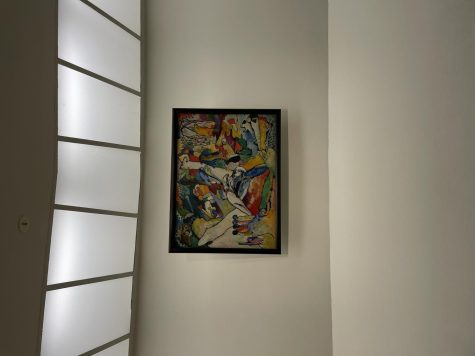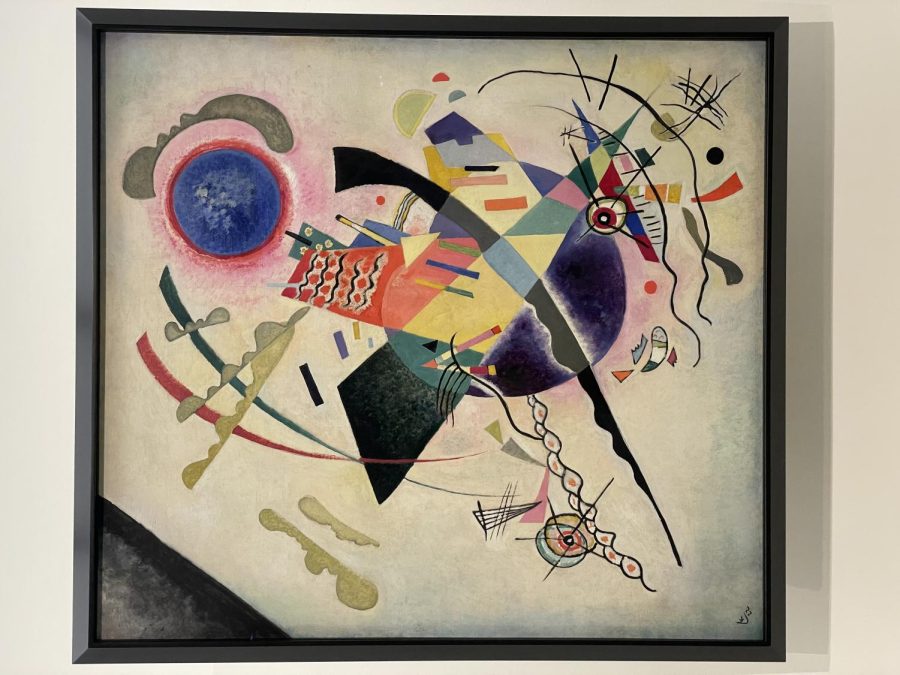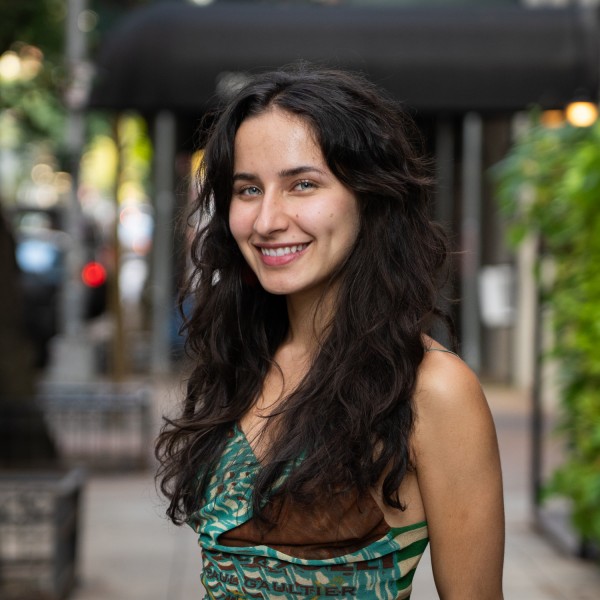Review: Guggenheim’s Kandinsky exhibition uncovers layers of the abstract artist’s evolution
Each step around the Guggenheim’s spiral ramp reveals a different layer of Vasily Kandinsky’s groundbreaking career. “Vasily Kandinsky: Around the Circle” is currently on view at the Guggenheim until September 2022.
Vasily Kandinsky’s artworks draw from the peculiarities of his environment for emotive value. (Photo by Clara Scholl)
January 31, 2022
As Vasily Kandinsky’s paintings turn further away from visual reality and deeper into the abstract, reflecting not only his artistic progression but also his politicization, his work resonates all the more with modern audiences a century later. The Guggenheim exhibition “Vasily Kandinsky: Around the Circle” illustrates the artist’s expression and spirituality through a his characteristic vibrant colors, shapes and lines.
Credited as one of the pioneers of abstraction in western art, Wassily Wassilyevich Kandinsky, who lived from 1866 to 1944, was a painter and theorist who underwent a stylistic evolution unlike any other. At “Around the Circle,” an immersive experience that winds around the Solomon R. Guggenheim Museum’s iconic spiral ramp, each step a visitor takes uncovers another step on the path of Kandisky’s life.
“His was not a fixed path from representation to abstraction, but rather a circular passage traversing persistent themes centered around the pursuit of one dominant ideal: the impulse for spiritual expression,” reads the Guggenheim’s official notes on the exhibit.

Kandinsky did not set out for a career in the arts. He began his studies at the University of Moscow, where he graduated with degrees in law and economics. He did not begin his painting studies until he was 30 years old, after declining a teaching position at his alma mater.
Aware of the sociopolitical tensions before World War I, Kandinsky’s early work illustrates the “clash between matter and spirituality in human society,” the caption for “Sketch for Composition II” reads. Throughout his career, Kandinsky’s art trailed his political experiences. That sketch, for example, features two opposing sides: catastrophe on the left and paradise on the right.
This tension is also present in Kandinsky’s 1912 book “Concerning the Spiritual in Art,” in which the artist writes that “artwork … could counter the harm of materialism and introduce society to a more transcendent and communal way of being.” The abstraction he sought in his art opposed his generation’s fixation on material and practical production.
“Circles on Black,” created before Kandinsky moved to Germany following World War I and the Russian Revolution, broadened his use of shapes and intersecting levels of planes. He separated his work from mechanistic art, maintaining that his most abstract pieces had emotive value.
“The appearance of rotating shapes, black-and-white grids, and monochromatic backgrounds in his work emerged from his search for pure forms that could be emotive without directly referencing reality,” the caption attached to “Circles on Black” reads.
From Moscow to Munich, from Neuilly-sur-Seine to New York, Kandinsky’s art remains a lasting symbol of the search for personal expression during a time of political upheaval. He moved to France after the Bauhaus was closed by the Nazis, who later labeled his work “degenerate.”
The political dimension of Kandinsky’s life must resonate with today’s younger generation, which has grown up as a global pandemic surges, social media encroaches on all aspects of everyday life, and authoritarian ideologies threaten democratic politics. This generation has grown up politically aware, and Kandinsky’s style and oeuvre are reminders of how to rebel against hegemonic values and traditions.
Kandinsky is a breath of fresh air in terms of true artistic self-expression. He drew from the particularities of his environment, rather than from the predetermined mechanics of mass media and went against the primary ideology of the time. Through an exploration of form and color, Kandisky’s paintings continue to comment on necessary discourses in our highly politicized and materialistic culture.
“Vasily Kandinsky: Around the Circle” is currently on view at the Guggenheim until September 2022.
Contact Clara Scholl at [email protected].

























































































































































